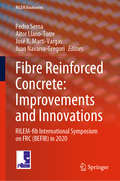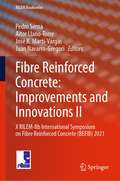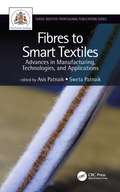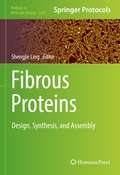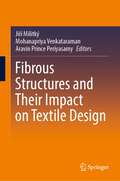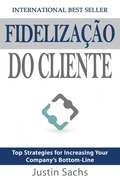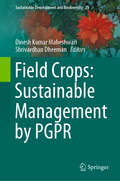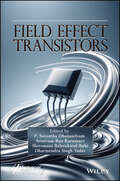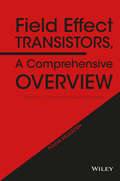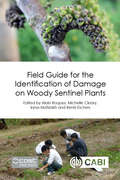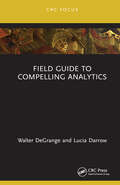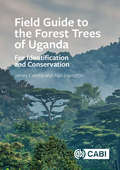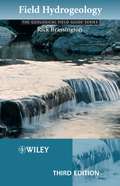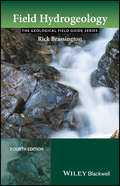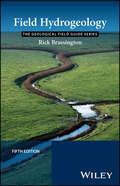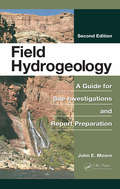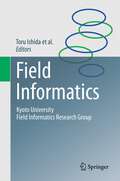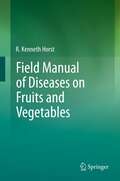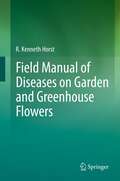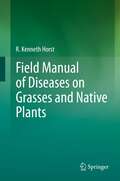- Table View
- List View
Fibre Reinforced Concrete: RILEM-fib International Symposium on FRC (BEFIB) in 2020 (RILEM Bookseries #30)
by Pedro Serna Aitor Llano-Torre José R. Martí-Vargas Juan Navarro-GregoriThis volume highlights the latest advances, innovations, and applications in the field of fibre reinforced concrete (FRC) and discusses a diverse range of topics concerning FRC: rheology and early-age properties, mechanical properties, codes and standards, long-term properties, durability, analytical and numerical models, quality control, structural and Industrial applications, smart FRC’s, nanotechnologies related to FRC, textile reinforced concrete, structural design and UHPFRC. The contributions present improved traditional and new ideas that will open novel research directions and foster multidisciplinary collaboration between different specialists. Although the symposium was postponed, the book gathers peer-reviewed papers selected in 2020 for the RILEM-fib International Symposium on Fibre Reinforced Concrete (BEFIB).
Fibre Reinforced Concrete: X RILEM-fib International Symposium on Fibre Reinforced Concrete (BEFIB) 2021 (RILEM Bookseries #36)
by Pedro Serna Aitor Llano-Torre José R. Martí-Vargas Juan Navarro-GregoriThis volume highlights the latest advances, innovations, and applications in the field of fibre-reinforced concrete (FRC), as presented by scientists and engineers at the RILEM-fib X International Symposium on Fibre Reinforced Concrete (BEFIB), held in Valencia, Spain, on September 20-22, 2021. It discusses a diverse range of topics concerning FRC: technological aspects, nanotechnologies related with FRC, mechanical properties, long-term properties, analytical and numerical models, structural design, codes and standards, quality control, case studies, Textile-Reinforced Concrete, Geopolymers and UHPFRC. After the symposium postponement in 2020, this new volume concludes the publication of the research works and knowledge of FRC in the frame of BEFIB from 2020 to 2021 with the successful celebration of the hybrid symposium BEFIB 2021. The contributions present traditional and new ideas that will open novel research directions and foster multidisciplinary collaboration between different specialists.
Fibres to Smart Textiles: Advances in Manufacturing, Technologies, and Applications (Textile Institute Professional Publications)
by Asis Patnaik Sweta PatnaikFibres to Smart Textiles: Advances in Manufacturing, Technologies, and Applications offers comprehensive coverage of the fundamentals and advances in the textile and clothing manufacturing sectors. It describes the basics of fibres, yarns, and fabrics and their end use in the latest developments and applications in the field and addresses environmental impacts from textile processes and how to minimize them. This book serves as a single comprehensive source discussing textile fibres, yarn formation, filament formation techniques, woven fabric formation, knitting technologies, nonwoven manufacturing technologies, braiding technologies, and dyeing, printing, and finishing processes. Testing of textile materials, environmental impacts of textile processes and use of CAD and CAM in designing textile products are also included. The book also discusses applications including textile composites and biocomposites, technical textiles, smart textiles, and nanotextiles. With chapters authored by textile experts, this practical book offers guidance to professionals in textile and clothing manufacturing and shows how to avoid potential pitfalls in product development.
Fibrous Polymeric Composites: Environmental Degradation and Damage
by Bankim Ray Rajesh Prusty Dinesh RathoreThis book emphasizes the scientific origin of deformation and damage of FRP composites under various environmental effects and analyses present understanding on degradation mechanisms, role of interfaces and addition of nanofillers Discusses micro-characterization of composites and interfaces, also includes micro-mechanisms and microscopic evidences to establish the structure-property correlation Elucidates advantages and limitations of FRP composites in supercritical applications
Fibrous Proteins: Design, Synthesis, and Assembly (Methods in Molecular Biology #2347)
by Shengjie LingThis detailed volume explores fibrous proteins widely present in different biological tissues or biological structural materials. The book begins by introducing the structure of representative fibrous proteins, including animal silks, collagen, elastin, resilin, and keratin, and it then continues by providing detailed experimental protocols for the synthesis, assembly, and characterization of natural, regenerated, and recombinant fibrous proteins. Written for the highly successful Methods in Molecular Biology series, chapters include introductions to their respective topics, lists of the necessary materials and reagents, step-by-step, readily reproducible laboratory protocols, and tips on troubleshooting and avoiding known pitfalls. Authoritative and practical, Fibrous Proteins: Design, Synthesis, and Assembly is an ideal guide for researchers aiming to master fibrous protein preparations with the aid of this broad and interdisciplinary perspective on understanding the structure-property-function relationships of natural and reconstituted fibrous proteins.
Fibrous Structures and Their Impact on Textile Design
by Aravin Prince Periyasamy Mohanapriya Venkataraman Jiří MilitkýBooks on Textiles tend to focus solely on aesthetic or technical points of view. Designers’ understanding of special technical aspects of textile structure or the ability of researchers to grasp the design aspects would result in quantum leaps in innovations and creativity in the Textile domain. This book presents a holistic view integrating the viewpoints of designers and researchers. It presents previously unexplored features or possibilities, mainly in the field of textile structure constructions and characteristics. The main aim is a unique proper blending of both the technical and aesthetic sides of textile. Without compromising on the technicalities, it simplifies complex concepts to elevate the understanding of fashion designers. On the other hand, it also provides a viewpoint on aesthetics. The chapters are designed to provide a good balance of content for both fashion designers and professionals. The initial chapter sets the foundation of understanding with a healthy discussion about the latest technical trends of textiles’ functionalities and their new applications. A dedicated chapter discusses the practical use of lighting effects of side-emitting optical fibers in conjunction with color effects for textile design purposes. Further chapters deal with smart textiles design in the context of sensation and perception, basic aspects of textiles structures necessary for their rational design, and color characteristics of materials useful for designers. The book includes a special chapter on analyzing the business landscape of textile design. Overall, this book is expected to cater to the needs and give special knowledge important for both textile specialists and fashion designers.
Fibrous and Textile Materials for Composite Applications
by Sohel Rana Raul FangueiroThis bookfocuses on the fibers and textiles used in composite materials. It presentsboth existing technologies currently used in commercial applications and thelatest advanced research and developments. It also discusses the differentfiber forms and architectures, such as short fibers, unidirectional tows,directionally oriented structures or advanced 2D- and 3D-textile structures that are used in composite materials. In addition, it examinesvarious synthetic, natural and metallic fibers that are used to reinforcepolymeric, cementitious and metallic matrices, as well as fiber properties,special functionalities, manufacturing processes, and composite processing andproperties. Two entire chapters are dedicated to advanced nanofiber andnanotube reinforced composite materials. The book goes on to highlightdifferent surface treatments and finishes that are applied to improvefiber/matrix interfaces and other essential composite properties. Although a great deal of information about fibers and textilestructures used for composite applications is already available, this is theonly book currently available that discusses all types of fibers and structuresused to reinforce polymers, cement, metal or soil to improve their generalperformance and multi-functional behaviors. As such, it fills an important gapin the available literature and provides a valuable resource for a wide rangeof students and researchers from academia and industry.
Fidelização Do Cliente
by Justin Sachs Bianca Busato PortellaFidelização do Cliente fornece as melhores ferramentas, estratégias e princípios dos melhores profissionais de negócios estratégicos do mundo. Trata-se de sistemas e práticas que empreendedores e líderes de empresas reais utilizam diariamente nos seus negócios para aumentar a fidelização do cliente e o valor do tempo de vida geral de seus clientes.
Fiducial Reference Measurements for Altimetry: Proceedings of the International Review Workshop on Satellite Altimetry Cal/Val Activities and Applications (International Association of Geodesy Symposia #150)
by Stelios P. Mertikas Roland PailThese proceedings include selected papers from the International Review Workshop on Satellite Altimetry Cal/Val Activities and Applications, held in Chania, Crete, Greece, on 23-26 April 2018. Organised in the context of the European Space Agency Project “Fiducial Reference Measurements for Altimetry” the workshop was cosponsored by the International Association of Geodesy (in particular by the IAG Commission 2, Gravity Field), the European Space Agency, the European Union (the Copernicus Programme), the European Organisation for the Exploitation of Meteorological Satellites (EUMETSAT), Space Geomatica P.C., and the Municipality of Chania.The workshop presented the latest research in the field of satellite altimetry calibration and altimetry applications for monitoring ocean changes and improving Earth observation in an objective, continuous, homogeneous and reliable manner, free of errors and biases. Further, it supported long-term monitoring of climate change by providing a better understanding of environmental changes in the world's oceans, terrestrial surface waters, and Arctic and Antarctic Regions. The outcome was the creation of a scientific roadmap with procedures, protocols, guidelines, and best practices to help international groups working on satellite altimetry to establish SI (Système International d'Unités) traceability of their measurements, results and data products.
Field Crops: Sustainable Management by PGPR (Sustainable Development and Biodiversity #23)
by Dinesh Kumar Maheshwari Shrivardhan DheemanThis book discusses the most challenging task ahead of researchers from India and around the globe: providing disease-free field crops for the ever-growing world population. In Asia, despite being cultivated in massive volumes, major crops, including cereals, oil seed, tuber and non-tuber vegetables, and fruit, are not meeting the demands of the increasing population. This book showcases naturally occurring beneficial microbes in the form of plant growth promoting rhizobacteria, or PGPR, which make it possible to grow field crops without applying synthetic chemicals.Our understanding of PGPR has increased exponentially in recent decades. They play a multifarious role in developing sustainable systems of crop production and protection. The book focuses on the mechanistic behaviors of PGPRs, their use to develop sustainable cultivation techniques, and their application to enhance crop growth and productivity at the cutting edge of tech-oriented agriculture and to replace hazardous chemicals with microbial inoculants. The book is useful to agronomists, microbiologists, ecologists, plant pathologists, molecular biologists, environmentalists, policy makers, conservationists, and NGOs working on organically grown field crops.
Field Effect Transistors
by Shiromani Balmukund Rahi K. Srinivasa Rao Dharmendra Singh Yadav P. Suveetha DhanaselvamField Effect Transistors is an essential read for anyone interested in the future of electronics, as it provides a comprehensive yet accessible exploration of innovative semiconductor devices and their applications, making it a perfect resource for both beginners and seasoned professionals in the field. Miniaturization has become the slogan of the electronics industry. Field Effect Transistors serves as a short encyclopedia for young minds looking for solutions in the miniaturization of semiconductor devices. It explores the characteristics, novel materials used, modifications in device structure, and advancements in model FET devices. Though many devices following Moore’s Law have been proposed and designed, a complete history of the existing and proposed semiconductor devices is not available. This book focuses on developments and research in emerging semiconductor FET devices and their applications, providing unique coverage of topics covering recent advancements and novel concepts in the field of miniaturized semiconductor devices. Field Effect Transistors is an easy-to-understand guide, making it excellent for those who are new to the subject, giving insight and analysis of recent developments and developed semiconductor device structures along with their applications.
Field Effect Transistors, A Comprehensive Overview
by Pouya ValizadehThis book discusses modern-day Metal Oxide Semiconductor Field Effect Transistors (MOSFETs) and future trends of transistor devices. This book provides an overview of Field Effect Transistors (FETs) by discussing the basic principles of FETs and exploring the latest technological developments in the field. It covers and connects a wide spectrum of topics related to semiconductor device physics, physics of transistors, and advanced transistor concepts. This book contains six chapters. Chapter 1 discusses electronic materials and charge. Chapter 2 examines junctions, discusses contacts under thermal-equilibrium, metal-semiconductor contacts, and metal-insulator-semiconductor systems. Chapter 3 covers traditional planar Metal Oxide Semiconductor Field Effect Transistors (MOSFETs). Chapter 4 describes scaling-driving technological variations and novel dimensions of MOSFETs. Chapter 5 analyzes Heterojunction Field Effect Transistors (FETs) and also discusses the challenges and rewards of heteroepitaxy. Finally, Chapter 6 examines FETs at molecular scales. Links the discussion of contemporary transistor devices to physical processes Material has been class-tested in undergraduate and graduate courses on the design of integrated circuit components taught by the author Contains examples and end-of-chapter problems Field Effect Transistors, A Comprehensive Overview: From Basic Concepts to Novel Technologies is a reference for senior undergraduate / graduate students and professional engineers needing insight into physics of operation of modern FETs.Pouya Valizadeh is Associate Professor in the Department of Electrical and Computer Engineering at Concordia University in Quebec, Canada. He received B.S. and M.S. degrees with honors from the University of Tehran and Ph.D. degree from The University of Michigan (Ann Arbor) all in Electrical Engineering in 1997, 1999, and 2005, respectively. Over the past decade, Dr. Valizadeh has taught numerous sections of five different courses covering topics such as semiconductor process technology, semiconductor materials and their properties, advanced solid state devices, transistor design for modern CMOS technology, and high speed transistors.
Field Guide for the Identification of Damage on Woody Sentinel Plants
by Thomas Cech Sylvie Augustin Marie-Anne Auger-Rozenberg Kalev Adamson Ayse Gülden Aday Kaya Dimitrios N Avtzis Yuri N Baranchikov Ellie Barham Marek Barta Refika Ceyda Beram Conceição Boavida Helena Bragança Daiva Burokiene György Csóka H. Tugba Dogmus Lehtijärvi Rein Drenkhan Jian-Ting Fan Milka Glavendekic Irinia Ionescu-Malancus Magdalena Kacprzyk Marc Kenis Natalia Kirichenko Ferenc Lakatos Asko Lehtijärvi Giorgio Maresi Carmen Morales-Rodríguez Ana Cristina Moreira Dmitry L Musolin Richard O'Hanlon Irena Papazova-Anakieva Leopold Poljakovic-Pajnik Simone Prospero Hans Ravn Andrey V Selikhovkin Venche Talgø Manole Traian Andrea Vannini Anna Maria Vettraino Johanna WitzellThis book is a heavily-illustrated, internationally applicable, practical guide for the identification of likely causal agents of damage to trees and woody shrubs. It is intended for use in sentinel plantings - a new tool to identify pests in the country of origin, used to inform pest risk analysis and risk mitigation measures - where agents often may not be known and only damage visible. Field Guide for the Identification of Damage on Woody Sentinel Plants: - Aids the identification of the type of agent that may have caused observed damage, including pathogens, invertebrates and abiotic factors. - Explains how to take and preserve samples and how to proceed to obtain a more definitive identification of pests. - Includes a general damage chapter in addition to specific chapters on damage to leaves, buds and shoots, roots, trunk, and flowers, fruits and seeds. - Contains 800 full colour, high quality photographs to aid analysis. This is an essential guide for plant health professionals, including inspectors for plant protection organizations, foresters and nursery managers, in addition to students of forest entomology and pathology.
Field Guide to Compelling Analytics (Chapman and Hall/CRC Focus Case Studies in Analytics and OR)
by Walter DeGrange Lucia DarrowField Guide to Compelling Analytics is written for Analytics Professionals (APs) who want to increase their probability of success in implementing analytical solutions. In the past, soft skills such as presentation and persuasive writing techniques have been the extent of teaching junior APs how to effectively communicate the value of analytical products. However, there are other aspects to success such as trust and experience that may play a more important role in convincing fellow APs, clients, advisors, and leadership groups that their analytic solutions will work. This book introduces the formula ‘Analytics + Trust + Communication + Experience > Convince Them’ to illustrate an AP’s ability to convince a stakeholder. The ‘Convince Me’ stakeholders might be an analytics team member, team lead, decision-maker, or senior leader that are either internal or external to the AP’s organization. Whoever they are, this formula represents a concise, digestible, and above all practical means to increase the likelihood that you will be able to persuade them of the value of your analytical product. Features Includes insight questions to support class discussion. Written in broadly non-mathematical terms, designed to be accessible to any level of student or practicing AP to read, understand, and implement the concepts. Each section introduces the ideas through real-life case studies.
Field Guide to the Forest Trees of Uganda: For Identification and Conservation
by Alan Hamilton James KalemaThis book is a guide for the identification of the indigenous forest trees of Uganda. It will be useful for those who wish to contribute towards the conservation of the forests or to plant indigenous trees. Information is provided on how to propagate and cultivate about 80 of the most valuable species. Indigenous trees provide numerous resources useful for welfare and development. They include many types of timber and non-timber forest products, such as craft materials, foods and medicines. The proximity of indigenous forest helps to moderate the local climate, making it more suitable for agriculture. Indigenous forests protect springs, therefore safeguarding water supplies more effectively than exotic trees such as pines and eucalyptus. All 450 known indigenous tree species from the forests are included. Both scientific and local names are provided, the latter in 21 languages. Local names facilitate access to knowledge and values traditionally attached to the species, useful when planning pathways of development firmly rooted in local culture. The book will be invaluable for botanists, foresters, rural development workers and members of the general public concerned about contributing to conservation and sustainable development in Uganda. Many of the species grow in neighbouring countries, so the book has relevance there too.
Field Hydrogeology
by Rick BrassingtonThe successful investigation of the hydrogeology of an area depends on the collection of reliable field data. Field Hydrogeology, Third Edition follows a systematic approach to completing a hydrogeological study and explains how to decide on the measurements that are needed and on the instruments and techniques required. Measurements that are needed and on the instruments and techniques required. Measurements of groundwater levels, rainfall and evaporation spring and stream flows and the use of ground water tracer techniques are covered. There is a great deal of practical information on all aspects of planning and completion of field investigation and on the interpretation of field investigation and on the interpretation of field evidence. Advice on safety is also included.This third edition has been fully revised and updated to bring the book into line with developments in environmental regulations. The order of the chapters reflects the structure of a hydrogeological project and the development of a conceptual model up to completion of a report. The focus is on current practical applications of hydrogeological investigations using new case histories and a new chapter on specialist techniques has been included.Handy pocket-size for field researchFeatures case historiesFocuses on practical applicationsContains a new chapter on groundwater investigationsField Hydrogeology, Third Edition is an invaluable resource for undergraduate and postgraduate students of geology, hydrogeology, environmental sciences and engineering, as well as a wide range of professionals working in the water resources and environmental protection fields.
Field Hydrogeology (Geological Field Guide)
by Rick BrassingtonThe fourth edition of this bestselling textbook has been fully revised in order to present the most up-to-date and comprehensive guide to completing a hydrogeological study. Beautifully presented with full colour photos and diagrams throughout, Field Hydrogeology retains its practical pocket size for easy use in the field. This new edition includes all the recent developments in the environmental regulations, with particular focus on the use of innovative technology. New topics include geothermal energy, soakaways, marrying manual water level readings with logger records, prediction of long-term drawdown and lateral extent of impacts, and flow measurement in locations with small head gradients. With case studies and text boxes to aid comprehension, and a particular emphasis on practical application, this is an essential tool for students taking Hydrogeology and/or field course modules in Geology, Earth Sciences, Hydrogeology and Engineering courses.
Field Hydrogeology (Geological Field Guide)
by Rick BrassingtonField Hydrogeology Pocket-sized field workbook for students studying hydrogeology at undergraduate and postgraduate levels The fully revised Fifth Edition of Field Hydrogeology serves as a comprehensive guide to conducting a hydrogeological study, beautifully presented with full colour photos and diagrams throughout, in a practical pocket size for easy use in the field. This new edition includes recent developments in the environmental regulations, with particular focus on the use of innovative technology. New topics in the Fifth Edition include the monitoring of boreholes using piezometers, how to identify the origin of water in the basement of a building, and an expanded section on geothermal energy. The text also includes case studies and text boxes to aid in reader comprehension, with a particular emphasis on practical application throughout. The Fifth Edition of Field Hydrogeology addresses key topics such as: Horizontal wells and shallow aquifers Complicated flow rates through the unsaturated zone The use of tritium, chlorofluorocarbons and sulphur hexafluoride in recharge studies Cleaning of boreholes using hydrogen peroxide and oxalic acid Field Hydrogeology is an essential tool for undergraduate and postgraduate students in Geology, Earth Sciences, Hydrogeology and Engineering courses who are learning to conduct fieldwork and need a handy pocket-sized guide to accompany them into the field.
Field Hydrogeology: A Guide for Site Investigations and Report Preparation, Second Edition
by John E. MooreIn recent years, the focus in hydrogeologic investigations has expanded to include aquifer sustainability as part of resource evaluations. While there are other books on the subject, Field Hydrogeology: A Guide for Site Investigations and Report Preparation provides the first integrated presentation of the American Society of Testing Materials (AST
Field Informatics
by Toru IshidaHere we use the term "field" to refer to a sphere of practical operation, and correspondingly the term "field informatics" describes informatics tools and methodologies that arise in the field. The components of field informatics are description, prediction, design and transfer, and the methods for those components vary widely. For example, we consider the social goal of revitalizing a mountainous area experiencing depopulation and we show how the tools and methodologies of field informatics may be used to describe such situations using remote sensing, biologging, human sensing and ethnography; the effects of various solutions can be predicted using system dynamics and multiagent simulations; the solutions can be designed using inclusive design or participatory design methods; and finally the experience gained can be transferred using case writing and outreach communication. The authors are specialists in diverse areas such as informatics, engineering, agriculture, sociology and pedagogy, and their areas of interest range from environment conservation to social education for international cooperation. They have a particular focus on the environment in southeast Asia and related topics such as large-scale traffic simulations, participatory workshops, inclusive design workshops, distance learning, and intercultural collaboration. This book targets graduate students seeking tools and methodologies for natural observation, field workers engaged in social participation, and researchers and engineers pursuing innovation. The techniques described in the book could also be exploited by government officials to form consensus and develop activities or by non-profit organizations to undertake more effective social programs.
Field Manual For Water Quality Monitoring: An Environmental Education Program For Schools
by Mark K. Mitchell William B. Stapp Earth Force Inc. StaffField Manual for Water Quality Monitoring: An Environmental Education Program for Schools
Field Manual of Diseases on Fruits and Vegetables
by R. Kenneth HorstThe Fruits and Vegetables manual is a reference manual on diseases which attack fruits (including berries), vegetables, and nuts. The manual identifies various types of diseases which are known to invade these plants located throughout North, Central, and South America. The recordings include diseases caused by fungi, bacteria, viruses, viroids, phytoplasmas, and nematodes. Causal disease agents are described and illustrated in some cases and diseases and disease control measures are also discussed. A manual such as this is never finished since new reports of diseases are continuously reported.
Field Manual of Diseases on Garden and Greenhouse Flowers
by R. Kenneth HorstThe Garden and Greenhouse Flowers manual is a reference manual on diseases which attack garden and greenhouse flowers. The manual identifies various types of diseases which are known to invade these plants located throughout North, Central, and South America.The recordings include diseases caused by fungi, bacteria, viruses, viroids, phytoplasmas, and nematodes. Causal disease agents are described and illustrated in some cases and diseases and disease control measures are also discussed. A manual such as this is never finished since new reports of diseases are continuously reported.
Field Manual of Diseases on Grasses and Native Plants
by R. Kenneth HorstThe Grasses and Native Plants manual is a reference manual on diseases which attack grasses, forage, native flowers, and weeds. The manual identifies various types of diseases which are known to invade these plants located throughout North, Central, and South America. The recordings include diseases caused by fungi, bacteria, viruses, viroids, phytoplasmas, and nematodes. Causal disease agents are described and illustrated in some cases and diseases and disease control measures are also discussed. A manual such as this is never finished since new reports of diseases are continuously reported.
Field Manual of Diseases on Trees and Shrubs
by R. Kenneth HorstThe Trees and Shrubs manual is a reference manual on diseases which attack trees, shrubs, and vines. The manual identifies various types of diseases which are known to invade these plants located throughout North, Central, and South America. The recordings include diseases caused by fungi, bacteria, viruses, viroids, phytoplasmas, and nematodes. Causal disease agents are described and illustrated in some cases and diseases and disease control measures are also discussed. A manual such as this is never finished since new reports of diseases are continuously reported.
